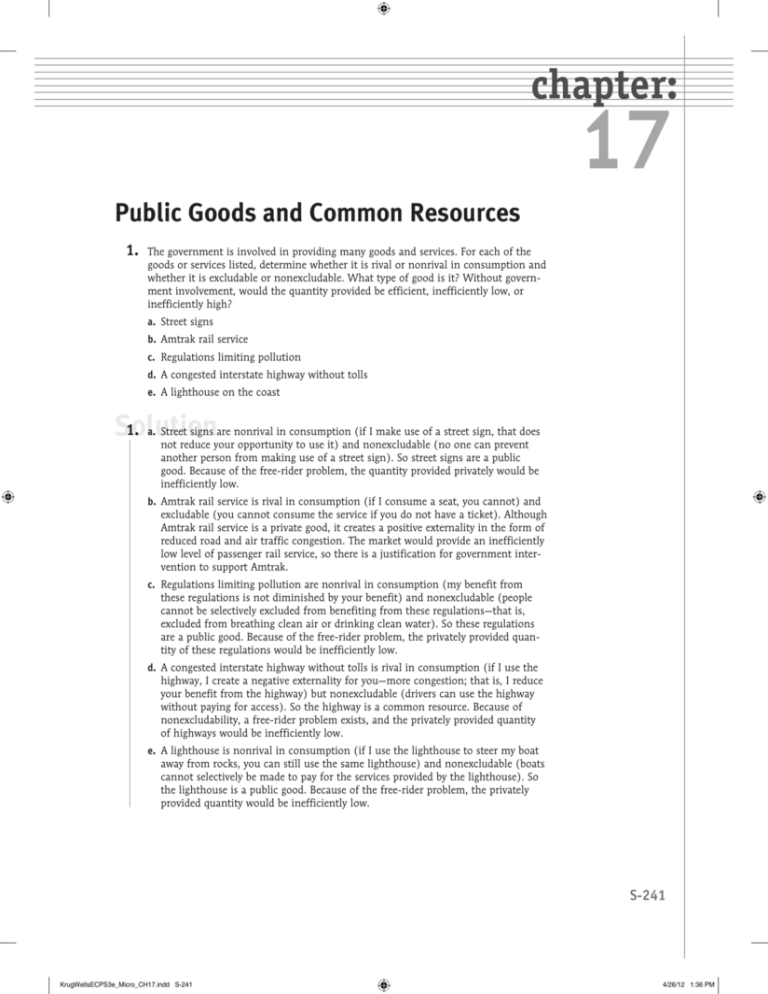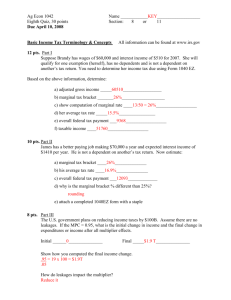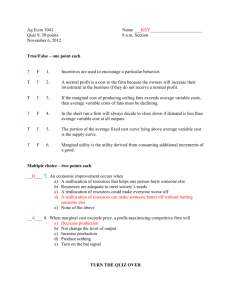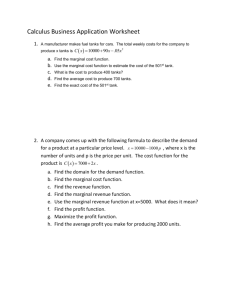Solution
advertisement

chapter: 17 Public Goods and Common Resources 1. The government is involved in providing many goods and services. For each of the goods or services listed, determine whether it is rival or nonrival in consumption and whether it is excludable or nonexcludable. What type of good is it? Without government involvement, would the quantity provided be efficient, inefficiently low, or inefficiently high? a. Street signs b. Amtrak rail service c. Regulations limiting pollution d. A congested interstate highway without tolls e. A lighthouse on the coast 1. Solution a. Street signs are nonrival in consumption (if I make use of a street sign, that does not reduce your opportunity to use it) and nonexcludable (no one can prevent another person from making use of a street sign). So street signs are a public good. Because of the free-rider problem, the quantity provided privately would be inefficiently low. b. Amtrak rail service is rival in consumption (if I consume a seat, you cannot) and excludable (you cannot consume the service if you do not have a ticket). Although Amtrak rail service is a private good, it creates a positive externality in the form of reduced road and air traffic congestion. The market would provide an inefficiently low level of passenger rail service, so there is a justification for government intervention to support Amtrak. c. Regulations limiting pollution are nonrival in consumption (my benefit from these regulations is not diminished by your benefit) and nonexcludable (people cannot be selectively excluded from benefiting from these regulations—that is, excluded from breathing clean air or drinking clean water). So these regulations are a public good. Because of the free-rider problem, the privately provided quantity of these regulations would be inefficiently low. d. A congested interstate highway without tolls is rival in consumption (if I use the highway, I create a negative externality for you—more congestion; that is, I reduce your benefit from the highway) but nonexcludable (drivers can use the highway without paying for access). So the highway is a common resource. Because of nonexcludability, a free-rider problem exists, and the privately provided quantity of highways would be inefficiently low. e. A lighthouse is nonrival in consumption (if I use the lighthouse to steer my boat away from rocks, you can still use the same lighthouse) and nonexcludable (boats cannot selectively be made to pay for the services provided by the lighthouse). So the lighthouse is a public good. Because of the free-rider problem, the privately provided quantity would be inefficiently low. S-241 KrugWellsECPS3e_Micro_CH17.indd S-241 4/26/12 1:36 PM S-242 C H A P T E R 17 PUBLIC GOODS AND COMMON RESOURCES 2. An economist gives the following advice to a museum director: “You should introduce ‘peak pricing.’ At times when the museum has few visitors, you should admit visitors for free. And at times when the museum has many visitors, you should charge a higher admission fee.” a. When the museum is quiet, is it rival or nonrival in consumption? Is it excludable or nonexcludable? What type of good is the museum at those times? What would be the efficient price to charge visitors during that time, and why? b. When the museum is busy, is it rival or nonrival in consumption? Is it excludable or nonexcludable? What type of good is the museum at those times? What would be the efficient price to charge visitors during that time, and why? 2. Solution a. When the museum is quiet, it is nonrival in consumption: one additional visitor does not diminish any other visitor’s ability to enjoy the museum. Furthermore, the museum is excludable (if you don’t pay the entrance fee, you are not admitted). So the museum is an artificially scarce good. The marginal cost of admitting one more visitor is zero (the museum is already staffed, lighted, and heated or airconditioned), and so the efficient admission fee would be zero. b. When the museum is busy, it is rival in consumption: one additional visitor in the museum diminishes any other visitor’s ability to enjoy the museum because of overcrowding. The museum is still excludable (if you don’t pay the entrance fee, you are not admitted). So the museum is a private good. There is now a marginal external cost to admitting one more visitor (the cost imposed on other visitors from a more crowded museum). So the efficient admission fee would be equal to the marginal external cost at the efficient number of visitors. 3. In many planned communities, various aspects of community living are subject to regulation by a homeowners’ association. These rules can regulate house architecture; require snow removal from sidewalks; exclude outdoor equipment, such as backyard swimming pools; require appropriate conduct in shared spaces such as the community clubhouse; and so on. Suppose there has been some conflict in one such community because some homeowners feel that some of the regulations mentioned above are overly intrusive. You have been called in to mediate. Using what you have learned about public goods and common resources, how would you decide what types of regulations are warranted and what types are not? Solution 3. Using efficiency as the goal, a regulation is warranted if it provides a public good or if it conserves a common resource. The enjoyment of pleasing and harmonious architecture and snow removal from sidewalks are examples of public goods: they are nonexcludable and nonrival in consumption. A clubhouse is a common resource: it is nonexcludable but rival in consumption. So it promotes efficiency if these aspects of the community are regulated for the benefit for all. But it is questionable whether or not aspects such as backyard swimming pools should be regulated: their presence in someone’s yard does not benefit or hurt neighbors (so they are rival in consumption) and they are solely for the benefit of the homeowner who owns them (they are excludable). So they are private goods and should not be subject to regulation by the homeowners’ association. The regulation of private goods in the community is unwarranted. KrugWellsECPS3e_Micro_CH17.indd S-242 4/26/12 1:36 PM CHAPTER 17 4. PUBLIC GOODS AND COMMON RESOURCES S-243 A residential community has 100 residents who are concerned about security. The accompanying table gives the total cost of hiring a 24-hour security service as well as each individual resident’s total benefit. Quantity of security guards Total cost Total individual benefit to each resident 0 $0 $0 1 150 10 2 300 16 3 450 18 4 600 19 a. Explain why the security service is a public good for the residents of the community. b. Calculate the marginal cost, the individual marginal benefit for each resident, and the marginal social benefit. c. If an individual resident were to decide about hiring and paying for security guards on his or her own, how many guards would that resident hire? d. If the residents act together, how many security guards will they hire? Solution 4. a. Security services are nonexcludable: as soon as security is provided to the community, every resident benefits from it. Security services are nonrival: if one resident enjoys protection, this does not diminish any other resident’s ability to enjoy the service. b. The accompanying table calculates the marginal cost, the individual marginal benefit, and the marginal social benefit. The marginal social benefit is just the individual marginal benefit times 100, since there are 100 residents. Quantity of security guards Total cost 0 $0 Marginal cost Total individual benefit to each resident 150 2 300 3 450 4 600 Marginal social benefit $10 $1,000 6 600 2 200 1 100 $0 $150 1 Individual marginal benefit 10 150 16 150 18 150 19 c. An individual resident would compare the marginal cost of hiring an additional security guard against his or her individual marginal benefit. Since the marginal cost of hiring even the first security guard exceeds the individual marginal benefit to the resident, the resident would decide to hire no security guards on his or her own. KrugWellsECPS3e_Micro_CH17.indd S-243 4/26/12 1:36 PM S-244 C H A P T E R 17 PUBLIC GOODS AND COMMON RESOURCES d. If the residents act together, they will compare the marginal cost of hiring an additional security guard against the marginal social benefit. They will therefore decide to hire 3 security guards. For the third security guard, the marginal social benefit of $200 exceeds the marginal cost of $150. But for the fourth security guard, the marginal cost of $150 would exceed the marginal social benefit of $100. 5. The accompanying table shows Tanisha’s and Ari’s individual marginal benefit of different amounts of street cleanings per month. Suppose that the marginal cost of street cleanings is constant at $9 each. Quantity of street cleanings per month Tanisha’s individual marginal benefit Ari’s individual marginal benefit $10 $8 6 4 2 1 0 1 2 3 a. If Tanisha had to pay for street cleaning on her own, how many street cleanings would there be? b. Calculate the marginal social benefit of street cleaning. What is the optimal number of street cleanings? c. Consider the optimal number of street cleanings. The last street cleaning of that number costs $9. Is Tanisha willing to pay for that last cleaning on her own? Is Ari willing to pay for that last cleaning on his own? Solution 5. a. If Tanisha had to pay for street cleaning on her own, she would pay for the street to be cleaned once: her individual marginal benefit of the first cleaning, $10, exceeds the marginal cost of $9. However, she would not pay for more than one: her marginal benefit of the second cleaning is $6, less than the marginal cost of $9. b. The accompanying table shows the marginal social benefit of street cleaning. The optimal number of street cleanings is 2: the marginal social benefit of the second cleaning is $10, which exceeds the marginal cost of $9. A third cleaning would be inefficient because its marginal social benefit is $3, less than the marginal cost of $9. Quantity of street cleanings per month Tanisha’s individual marginal benefit Ari’s individual marginal benefit Marginal social benefit $10 $8 $18 6 4 10 2 1 3 0 1 2 3 KrugWellsECPS3e_Micro_CH17.indd S-244 4/26/12 1:36 PM CHAPTER 17 PUBLIC GOODS AND COMMON RESOURCES S-245 c. Tanisha on her own would be willing to pay only $6 (her individual marginal benefit) for the second cleaning. Ari on his own would be willing to pay only $4 (his individual marginal benefit) for the second cleaning. So neither would be individually willing to pay for the second cleaning. 6. Anyone with a radio receiver can listen to public radio, which is funded largely by donations. a. Is public radio excludable or nonexcludable? Is it rival in consumption or nonrival? What type of good is it? b. Should the government support public radio? Explain your reasoning. c. In order to finance itself, public radio decides to transmit only to satellite radios, for which users have to pay a fee. What type of good is public radio then? Will the quantity of radio listening be efficient? Why or why not? Solution 6. a. Public radio is nonexcludable: anyone with a radio receiver can pick up the radio waves. It is nonrival: if I listen to public radio, that does not diminish your opportunity to listen to it also. So public radio is a public good. b. As with all public goods, private markets lead to an inefficient quantity of the good being supplied. The individual marginal benefit from a certain amount of public radio programming is less than the marginal social benefit from that amount of public radio programming. So individuals are not willing to pay for the efficient level of public radio programming, and as a result the privately provided quantity of programming would be inefficiently low. There is a case for government support of public radio. c. Transmitting only to satellite radios, where a fee is charged for the service, makes public radio excludable. So public radio is now an artificially scarce good. The efficient price for receiving the satellite radio signal would be zero, since the marginal cost is zero. But since a positive price is charged, only consumers with a marginal benefit greater than or equal to that price will choose to purchase the good. As a result, there are many consumers with individual marginal benefits that exceed the marginal cost but who do not get access to public radio because the price exceeds their individual marginal benefit. The quantity of radio listening is therefore inefficiently low. 7. Your economics professor assigns a group project for the course. Describe the freerider problem that can lead to a suboptimal outcome for your group. To combat this problem, the instructor asks you to evaluate the contribution of your peers in a confidential report. Will this evaluation have the desired effects? Solution 7. Without the confidential evaluation, the grade a member of a group receives on the assignment depends only on the project as a whole, not on the contributions of individual members. Since each member of the group is aware of this, they realize that it is possible to shirk undetected and free-ride on the efforts of others. Consequently, everyone in the group is likely to underperform. The confidential peer evaluation provides an incentive to a potential free-rider to work harder. Since shirkers may be discovered through this evaluation and receive a lower grade as a result, the free-rider problem is mitigated. KrugWellsECPS3e_Micro_CH17.indd S-245 4/26/12 1:36 PM S-246 C H A P T E R 17 PUBLIC GOODS AND COMMON RESOURCES 8. The village of Upper Bigglesworth has a village “commons,” a piece of land on which each villager, by law, is free to graze his or her cows. Use of the commons is measured in units of the number of cows grazing on it. Assume that the marginal private cost curve of cow-grazing on the commons is upward-sloping (say due to more time spent herding). There is also a marginal social cost curve of cow-grazing on the commons: each additional cow grazed means less grass available for others, and the damage done by overgrazing of the commons increases as the number of cows grazing increases. Finally, assume that the private benefit to the villagers of each additional cow grazing on the commons declines as more cows graze, since each additional cow has less grass to eat than the previous one. a. Is the commons excludable or nonexcludable? Is it rival in consumption or nonrival? What kind of good is the commons? b. Draw a diagram showing the marginal social cost, marginal private cost, and the marginal private benefit of cow-grazing on the commons, with the quantity of cows that graze on the commons on the horizontal axis. How does the quantity of cows grazing in the absence of government intervention compare to the efficient quantity? Show both in your diagram. c. The villagers hire you to tell them how to achieve an efficient use of the commons. You tell them that there are three possibilities: a Pigouvian tax, the assignment of property rights over the commons, and a system of tradable licenses for the right to graze a cow. Explain how each one of these options would lead to an efficient use of the commons. In the assignment of property rights, assume that one person is assigned the rights to the commons and the rights to all the cows. Draw a diagram that shows the Pigouvian tax. 8. Solution a. The commons is nonexcludable since, by law, each villager is free to send his or her cows there. It is also rival in consumption, since the grass that one villager’s cow eats is no longer available for another villager’s cow. So the commons is a common resource. b. The accompanying diagram shows the marginal private cost to villagers of cowgrazing on the commons, MPC. It is also the supply curve of cows for grazing. It lies below the marginal social cost curve, MSC. MSC is higher than MPC because each villager who sends his or her cow to graze inflicts a cost on every other villager, a cost that increases as the number of cows grazing increases. The marginal private benefit curve, MPB, shows the marginal benefit that accrues to villagers according to the number of cows grazing. Price of cow grazing MSC O MPC EMKT MPB QOPT QMKT Quantity of cows grazing KrugWellsECPS3e_Micro_CH17.indd S-246 4/26/12 1:36 PM CHAPTER 17 PUBLIC GOODS AND COMMON RESOURCES S-247 The outcome without government intervention is indicated by QMKT , the quantity at which the marginal private benefit equals marginal private cost. It is greater than the optimal, or efficient, equilibrium quantity, QOPT . That is, the villagers will send too many cows to the commons to graze. This problem is known as the “tragedy of the commons” [G. Hardin, “The Tragedy of the Commons,” Science, pp. 1243–1248, 1968]. c. A Pigouvian tax on grazing would increase the villagers’ marginal cost and shift the MPC upward until it intersects MPB at the efficient quantity, QOPT . This is shown in the diagram as the movement of MPC to its new position at MPC1. Each individual villager would now make the socially optimal, or efficient, decision. Alternatively, ownership of the commons and the cows could be assigned to one person. He or she would set the amount of grazing to the efficient quantity. Last, villagers could create a system of tradable licenses for grazing one cow, where the number of licenses issued is equal to the efficient quantity of grazing. Price of cow grazing MSC MPC1 O Pigouvian tax EMKT MPC MPB QOPT QMKT Quantity of cows grazing 9. Prior to 2003, the city of London was often one big parking lot. Traffic jams were common, and it could take hours to travel a couple of miles. Each additional commuter contributed to the congestion, which can be measured by the total number of cars on London roads. Although each commuter suffered by spending valuable time in traffic, none of them paid for the inconvenience they caused others. The total cost of travel includes the opportunity cost of time spent in traffic and any fees levied by London authorities. a. Draw a graph illustrating the overuse of London roads, assuming that there is no fee to enter London in a vehicle and that roads are a common resource. Put the cost of travel on the vertical axis and the quantity of cars on the horizontal axis. Draw typical demand, individual marginal cost (MC), and marginal social cost (MSC) curves and label the equilibrium point. (Hint: The marginal cost takes into account the opportunity cost of spending time on the road for individual drivers but not the inconvenience they cause to others.) b. In February 2003, the city of London began charging a £5 congestion fee on all vehicles traveling in London. Illustrate the effects of this congestion charge on your graph and label the new equilibrium point. Assume the new equilibrium point is not optimally set (that is, assume that the £5 charge is too low relative to what would be efficient). c. The congestion fee was raised to £9 in January 2011. Illustrate the new equilibrium point on your graph, assuming the new charge is now optimally set. KrugWellsECPS3e_Micro_CH17.indd S-247 4/26/12 1:36 PM S-248 C H A P T E R 17 PUBLIC GOODS AND COMMON RESOURCES Solution 9. a. The accompanying diagram depicts the demand and individual marginal cost (MC1) for using London roads. When no fees are levied for using the roads, the equilibrium point is EMKT. This is the usual market equilibrium when market externalities are not corrected. Cost of travel MSC O MC1 EMKT D QOPT QMKT Quantity of cars b. After the £5 fee is imposed, the market equilibrium moves as shown in the accompanying diagram. The congestion charge effectively increases the cost of traveling by car in London, and the marginal cost curve shifts upward, from MC1 to MC2. The commuters who are easily able to switch to public transport stop driving, causing the quantity of cars to fall. However, the charge is too low: although the quantity of cars falls relative to the situation in part a, it is still greater than the efficient quantity, QOPT. Cost of travel MSC Upward shift by £5 MC2 O EMKT MC1 D QOPT QMKT KrugWellsECPS3e_Micro_CH17.indd S-248 Quantity of cars 4/26/12 1:36 PM CHAPTER 17 PUBLIC GOODS AND COMMON RESOURCES S-249 c. When the fee is raised to £9, the marginal cost curve moves farther up, to MC3, and more people refrain from using London roads as the equilibrium quantity falls to the efficient quantity, QOPT. The charge of £9 is the optimal Pigouvian tax in this case: it moves the equilibrium to the efficient outcome, O. Cost of travel MSC MC3 Upward shift by £9 O = EMKT MC1 D QOPT = QMKT 10. Quantity of cars The accompanying table shows six consumers’ willingness to pay (his or her individual marginal benefit) for one MP3 file copy of a Jay-Z album. The marginal cost of making the file accessible to one additional consumer is constant, at zero. Consumer Individual marginal benefit Adriana $2 Bhagesh 15 Chizuko 1 Denzel 10 Emma 5 Frank 4 a. What would be the efficient price to charge for a download of the file? b. All six consumers are able to download the file for free from a file-sharing service, Pantster. Which consumers will download the file? What will be the total consumer surplus to those consumers? c. Pantster is shut down for copyright law infringement. In order to download the file, consumers now have to pay $4.99 at a commercial music site. Which consumers will download the file? What will be the total consumer surplus to those consumers? How much producer surplus accrues to the commercial music site? What is the total surplus? What is the deadweight loss from the new pricing policy? 10. Solution a. Since the marginal cost of delivering the good to one additional consumer is zero, the efficient price would be zero. b. Since each of the six consumers has a marginal benefit greater than zero, all six will download the file. Adriana’s individual consumer surplus will be $2, Bhagesh’s $15, Chizuko’s $1, Denzel’s $10, Emma’s $5, and Frank’s $4. The total consumer surplus is therefore $2 + $15 + $1 + $10 + $5 + $4 = $37. KrugWellsECPS3e_Micro_CH17.indd S-249 4/26/12 1:36 PM S-250 C H A P T E R 17 PUBLIC GOODS AND COMMON RESOURCES c. At a price of $4.99, Bhagesh, Denzel, and Emma will download the file. Bhagesh’s individual consumer surplus will be $10.01, Denzel’s $5.01, and Emma’s $0.01. So total consumer surplus is $10.01 + $5.01 + $0.01 = $15.03. Producer surplus is 3 × $4.99 = $14.97. So total surplus is $15.03 + $14.97 = $30. This is $7 less than in part b. So the deadweight loss from making the good artificially scarce is $7. 11. Butchart Gardens is a very large garden in Victoria, British Columbia, renowned for its beautiful plants. It is so large that it could hold many times more visitors than currently visit it. The garden charges an admission fee of $30. At this price, 1,000 people visit the garden each day. If admission were free, 2,000 people would visit each day. a. Are visits to Butchart Gardens excludable or nonexcludable? Are they rival in consumption or nonrival? What type of good is it? b. In a diagram, illustrate the demand curve for visits to Butchart Gardens. Indicate the situation when Butchart Gardens charges an admission fee of $30. Also indicate the situation when Butchart Gardens charges no admission fee. c. Illustrate the deadweight loss from charging a $30 admission fee. Explain why charging this admission fee is inefficient. Solution 11. a. Visits to Butchart Gardens are excludable (there is an entrance fee) and nonrival (the garden could hold many more visitors than it currently hosts, so one visitor’s enjoyment of the park does not diminish another visitor’s enjoyment). So visits to Butchart Gardens are an artificially scarce good. b. The demand curve is illustrated in the accompanying diagram. The situation when Butchart Gardens charges a $30 admission fee is indicated by point A on the demand curve. The situation when Butchart Gardens charges no admission fee is indicated by point B on the demand curve. Price of visit C$32.48 D A Deadweight loss B 0 1,000 2,000 Quantity of visits c. The deadweight loss from charging a $30 admission fee rather than no fee is indicated by the shaded area in the diagram. Since the marginal cost of admitting one more visitor is zero, it would be efficient to charge no admission. However, since the good is artificially scarce and an admission fee of $30 is charged, only those consumers with a marginal benefit greater than $30 will visit the gardens. There are 1,000 consumers who have marginal benefits that exceed the marginal cost of allowing them access, but they are prevented from visiting the gardens by the $30 admission fee. KrugWellsECPS3e_Micro_CH17.indd S-250 4/26/12 1:36 PM CHAPTER 17 12. PUBLIC GOODS AND COMMON RESOURCES S-251 Software has historically been an artificially scarce good—it is nonrival because the cost of replication is negligible once the investment to write the code is made, but software companies make it excludable by charging for user licenses. But then opensource software emerged, most of which is free to download and can be modified and maintained by anyone. a. Discuss the free-rider problem that might exist in the development of open-source software. What effect might this have on quality? Why does this problem not exist for proprietary software, such as the products of a company like Microsoft or Adobe? b. Some argue that open-source software serves an unsatisfied market demand that proprietary software ignores. Draw a typical diagram that illustrates how proprietary software may be underproduced. Put the price and marginal cost of software on the vertical axis and the quantity of software on the horizontal axis. Draw a typical demand curve and a marginal cost curve (MC) that is always equal to zero. Assume that the software company charges a positive price, P, for the software. Label the equilibrium point and the efficient point. Solution 12. a. In principle, the developers of open-source software are not strictly monitored. Some developers may shirk and write poor code in the hope that others in the development community will correct their mistakes. A free-rider problem is created because individual developers are not held responsible for their code, potentially resulting in poor quality. Microsoft and Adobe, however, are responsible for the quality of their software; they risk losing business and profits if their product is substandard. So company management enforces quality-control measures that mitigate the free-rider problem. b. The accompanying diagram shows a demand curve, D, and a marginal cost curve that is constant and always equal to zero, MC. The equilibrium is at point EMKT , with a quantity, QMKT , that is lower than the efficient quantity, QOPT . Price, marginal D cost of software P EMKT MC = O O QMKT QOPT Quantity of software 13. In developing a vaccine for the SARS virus, a pharmaceutical company incurs a very high fixed cost. The marginal cost of delivering the vaccine to patients, however, is negligible (consider it to be equal to zero). The pharmaceutical company holds the exclusive patent to the vaccine. You are a regulator who must decide what price the pharmaceutical company is allowed to charge. a. Draw a diagram that shows the price for the vaccine that would arise if the company is unregulated, and label it PM. What is the efficient price for the vaccine? Show the deadweight loss that arises from the price PM. KrugWellsECPS3e_Micro_CH17.indd S-251 4/26/12 1:36 PM S-252 C H A P T E R 17 PUBLIC GOODS AND COMMON RESOURCES b. On another diagram, show the lowest price that the regulator can enforce that would still induce the pharmaceutical company to develop the vaccine. Label it P*. Show the deadweight loss that arises from this price. How does it compare to the deadweight loss that arises from the price PM? c. Suppose you have accurate information about the pharmaceutical company’s fixed cost. How could you use price regulation of the pharmaceutical company, combined with a subsidy to the company, to have the efficient quantity of the vaccine provided at the lowest cost to the government? Solution 13. a. If the company is unregulated, it will behave like a monopolist and choose a quantity, QM, at which marginal revenue is equal to marginal cost, which is equal to zero. This leads to the price PM. The efficient price, however, is zero. There is a deadweight loss equal to the shaded area in the accompanying diagram. Price, cost, marginal revenue Deadweight loss at PM PM ATC 0 D QM Quantity of vaccine MR b. The lowest price that still induces the company to develop the vaccine is the price at which the demand curve crosses the average total cost curve. At this price, the company just breaks even. There is a smaller deadweight loss than under the price PM. The deadweight loss is indicated by the shaded area in the accompanying diagram. Price, cost, marginal revenue PM Deadweight loss at P* P* 0 ATC D QM Q* Quantity of vaccine MR c. You could regulate the company’s price to be equal to zero. That way, all consumers with a positive willingness to pay will get the vaccine. To guarantee that the company will develop the vaccine, the government will pay the company a subsidy equal to its fixed cost. KrugWellsECPS3e_Micro_CH17.indd S-252 4/26/12 1:36 PM






